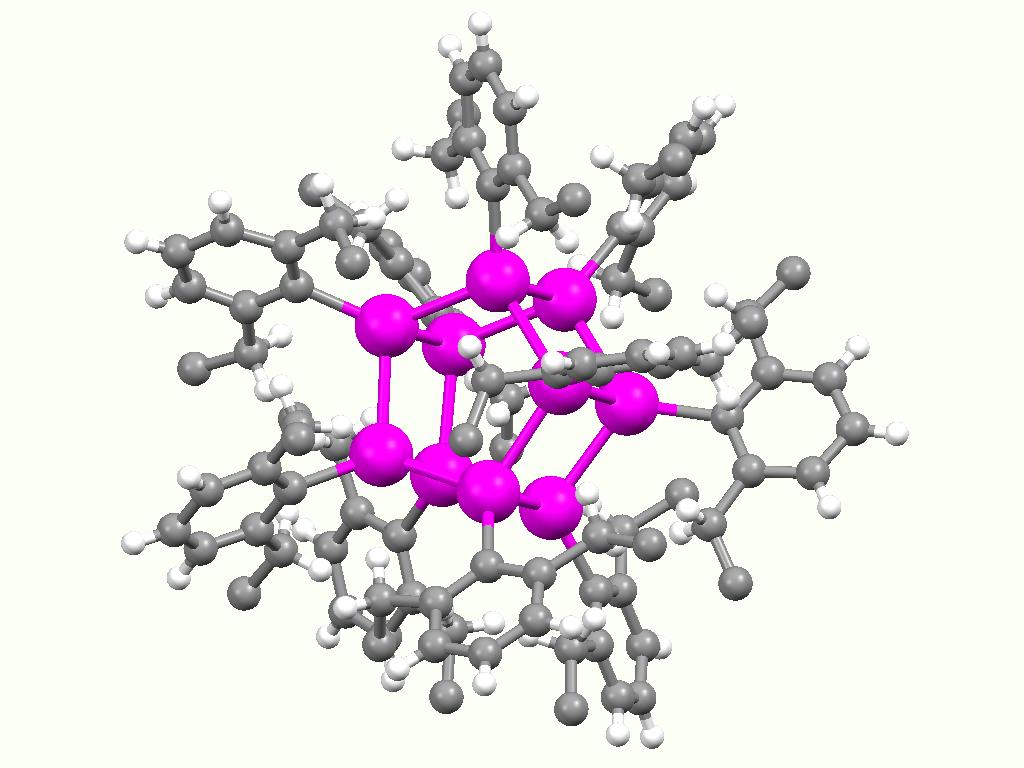|
Triethylboron
Triethylborane (TEB), also called triethylboron, is an organoborane (a compound with a B–C bond). It is a colorless pyrophoric liquid. Its chemical formula is or , abbreviated . It is soluble in organic solvents tetrahydrofuran and hexane. Preparation and structure Triethylborane is prepared by the reaction of trimethyl borate with triethylaluminium: :Et3Al + (MeO)3B → Et3B + (MeO)3Al The molecule is monomeric, unlike H3B and Et3Al, which tend to dimerize. It has a planar BC3 core. Applications Turbojet engine Triethylborane was used to ignite the JP-7 fuel in the Pratt & Whitney J58 turbojet/ramjet engines powering the Lockheed SR-71 Blackbird and its predecessor, the A-12 OXCART. Triethylborane is suitable because it ignites readily upon exposure to oxygen. It was chosen as an ignition method for reliability reasons, and in the case of the Blackbird, because JP-7 fuel has very low volatility and is difficult to ignite. Conventional ignition plugs posed a high risk of malf ... [...More Info...] [...Related Items...] OR: [Wikipedia] [Google] [Baidu] |
Organoborane
Organoborane or organoboron compounds are chemical compounds of boron and carbon that are organic derivatives of BH3, for example trialkyl boranes. Organoboron chemistry or organoborane chemistry is the chemistry of these compounds. Organoboron compounds are important reagents in organic chemistry enabling many chemical transformations, the most important one called hydroboration. Reactions of organoborates and boranes involve the transfer of a nucleophilic group attached to boron to an electrophilic center either inter- or intramolecularly. α,β-Unsaturated borates, as well as borates with a leaving group at the α position, are highly susceptible to intramolecular 1,2-migration of a group from boron to the electrophilic α position. Oxidation or protonolysis of the resulting organoboranes may generate a variety of organic products, including alcohols, carbonyl compounds, alkenes, and halides. Properties of the B-C bond The C-B bond has low polarity (the difference in elect ... [...More Info...] [...Related Items...] OR: [Wikipedia] [Google] [Baidu] |
Tetraethyllead
Tetraethyllead (commonly styled tetraethyl lead), abbreviated TEL, is an organolead compound with the formula Pb( C2H5)4. It is a fuel additive, first being mixed with gasoline beginning in the 1920s as a patented octane rating booster that allowed engine compression to be raised substantially. This in turn increased vehicle performance and fuel economy. TEL was first synthesised by German chemist Carl Jacob Löwig in 1853. American chemical engineer Thomas Midgley Jr., who was working for General Motors, was the first to discover its effectiveness as an antiknock agent in 1921, after spending several years attempting to find an additive that was both highly effective and inexpensive. Concerns were later raised over the toxic effects of lead, especially on children. On cars not designed to operate on leaded gasoline, lead and lead oxides coat the catalyst in catalytic converters, rendering them ineffective, and can sometimes foul spark plugs. Starting in the 1970s, many ... [...More Info...] [...Related Items...] OR: [Wikipedia] [Google] [Baidu] |
Afterburner
An afterburner (or reheat in British English) is an additional combustion component used on some jet engines, mostly those on military supersonic aircraft. Its purpose is to increase thrust, usually for supersonic flight, takeoff, and combat. The afterburning process injects additional fuel into a combustor in the jet pipe behind (''i.e.'', "after") the turbine, "reheating" the exhaust gas. Afterburning significantly increases thrust as an alternative to using a bigger engine with its attendant weight penalty, but at the cost of increased fuel consumption (decreased fuel efficiency) which limits its use to short periods. This aircraft application of "reheat" contrasts with the meaning and implementation of "reheat" applicable to gas turbines driving electrical generators and which reduces fuel consumption. Jet engines are referred to as operating ''wet'' when afterburning and ''dry'' when not. An engine producing maximum thrust wet is at ''maximum power,'' while an engine pro ... [...More Info...] [...Related Items...] OR: [Wikipedia] [Google] [Baidu] |
Metal Bis(trimethylsilyl)amides
Metal bis(trimethylsilyl)amides (often abbreviated as metal silylamides) are coordination complexes composed of a cationic metal with anionic bis(trimethylsilyl)amide ligands and are part of a broader category of metal amides. Due to the bulky hydrocarbon backbone metal bis(trimethylsilyl)amide complexes have low lattice energies and are lipophilic . For this reason, they are soluble in a range of nonpolar organic solvents, in contrast to simple metal halides, which only dissolve in reactive solvents. These steric bulky complexes are molecular, consisting of mono-, di-, and tetramers. Having a built-in base, these compounds conveniently react with even weakly protic reagents. The class of ligands and pioneering studies on their coordination compounds were described by Bürger and Wannagat. The ligands are often denoted ''hmds'' (e.g. M(N(SiMe3)2)3 = M(hmds)3) in reference to the hexamethyldisilazane from which they are prepared. General methods of preparation Apart from group ... [...More Info...] [...Related Items...] OR: [Wikipedia] [Google] [Baidu] |
John Wiley & Sons
John Wiley & Sons, Inc., commonly known as Wiley (), is an American multinational publishing company founded in 1807 that focuses on academic publishing and instructional materials. The company produces books, journals, and encyclopedias, in print and electronically, as well as online products and services, training materials, and educational materials for undergraduate, graduate, and continuing education students. History The company was established in 1807 when Charles Wiley opened a print shop in Manhattan. The company was the publisher of 19th century American literary figures like James Fenimore Cooper, Washington Irving, Herman Melville, and Edgar Allan Poe, as well as of legal, religious, and other non-fiction titles. The firm took its current name in 1865. Wiley later shifted its focus to scientific, technical, and engineering subject areas, abandoning its literary interests. Wiley's son John (born in Flatbush, New York, October 4, 1808; died in East Orange, ... [...More Info...] [...Related Items...] OR: [Wikipedia] [Google] [Baidu] |
Potassium Hydride
Potassium hydride, KH, is the inorganic compound of potassium and hydrogen. It is an alkali metal hydride. It is a white solid, although commercial samples appear gray. It is a powerful superbase that is useful in organic synthesis. It is sold commercially as a slurry (~35%) in mineral oil or sometimes paraffin wax to facilitate dispensing. Preparation Potassium hydride is produced by direct combination of the metal and hydrogen: : This reaction was discovered by Humphry Davy soon after his 1807 discovery of potassium, when he noted that the metal would vaporize in a current of hydrogen when heated just below its boiling point.Humphry Davy (1808), ''The Bakerian Lecture on some new phenomena of chemical changes produced by electricity, particularly the decomposition of fixed alkalies, and the exhibition of the new substances which constitute their bases; and on the general nature of alkaline bodies.'' Philosophical Transactions of the Royal Society, volume 88, pages 1–44. In '' ... [...More Info...] [...Related Items...] OR: [Wikipedia] [Google] [Baidu] |
Enolate
In organic chemistry, enolates are organic anions derived from the deprotonation of carbonyl () compounds. Rarely isolated, they are widely used as reagents in the synthesis of organic compounds. Bonding and structure Enolate anions are electronically related to allyl anions. The anionic charge is delocalized over the oxygen and the two carbon sites. Thus they have the character of both an alkoxide and a carbanion. Although they are often drawn as being simple salts, in fact they adopt complicated structures often featuring aggregates. Preparation Deprotonation of enolizable ketones, aromatic alcohols, aldehydes, and esters gives enolates. With strong bases, the deprotonation is quantitative. Typically enolates are generated from using lithium diisopropylamide (LDA). Often, as in conventional Claisen condensations, Mannich reactions, and aldol condensations, enolates are generated in low concentrations with alkoxide bases. Under such conditions, they exist in low con ... [...More Info...] [...Related Items...] OR: [Wikipedia] [Google] [Baidu] |
Organotin
Organotin compounds or stannanes are chemical compounds based on tin with hydrocarbon substituents. Organotin chemistry is part of the wider field of organometallic chemistry. The first organotin compound was diethyltin diiodide (), discovered by Edward Frankland in 1849. The area grew rapidly in the 1900s, especially after the discovery of the Grignard reagents, which are useful for producing Sn–C bonds. The area remains rich with many applications in industry and continuing activity in the research laboratory. Structure Organotin compounds are generally classified according to their oxidation states. Tin(IV) compounds are much more common and more useful. Organic derivatives of tin(IV) The tetraorgano derivatives are invariably tetrahedral. Compounds of the type SnRR'R''R have been resolved into individual enantiomers. Organotin halides Organotin chlorides have the formula for values of ''n'' up to 3. Bromides, iodides, and fluorides are also known but less important. ... [...More Info...] [...Related Items...] OR: [Wikipedia] [Google] [Baidu] |
Ullmann's Encyclopedia Of Industrial Chemistry
''Ullmann's Encyclopedia of Industrial Chemistry'' is a major reference work related to industrial chemistry by Chemist Fritz Ullmann, first published in 1914, and exclusively in German as "Enzyklopädie der Technischen Chemie" until 1984. History Ullmann's Encyclopedia of Industrial Chemistry is a major reference work related to industrial chemistry by chemist Fritz Ullmann. Its 1st edition was published in German by Fritz Ullmann in 1914. The 4th edition, published 1972 to 1984, already contained 25 volumes. The 5th edition, published 1985 to 1996, was the first version available in English. In 1997, the first online version was published. 2014 marked its centenary. As of 2016, Ullmann's Encyclopedia was in its 7th edition, in 40 volumes including one index volume and more than 1,050 articles (200 more than the 6th edition), approx. 30,000 pages, 22,000 images, 8,000 tables, 19,000 references and 85,000 indices. Editions * 1914–1922: 1st edition in 12 volumes, whic ... [...More Info...] [...Related Items...] OR: [Wikipedia] [Google] [Baidu] |
Radical (chemistry)
In chemistry, a radical, also known as a free radical, is an atom, molecule, or ion that has at least one unpaired electron, unpaired valence electron. With some exceptions, these unpaired electrons make radicals highly chemical reaction, chemically reactive. Many radicals spontaneously dimer (chemistry), dimerize. Most organic radicals have short lifetimes. A notable example of a radical is the hydroxyl radical (HO·), a molecule that has one unpaired electron on the oxygen atom. Two other examples are triplet oxygen and methylene radical, triplet carbene (꞉) which have two unpaired electrons. Radicals may be generated in a number of ways, but typical methods involve redox reactions. Ionizing radiation, heat, electrical discharges, and electrolysis are known to produce radicals. Radicals are intermediates in many chemical reactions, more so than is apparent from the balanced equations. Radicals are important in combustion, atmospheric chemistry, polymerization, Plasma (ph ... [...More Info...] [...Related Items...] OR: [Wikipedia] [Google] [Baidu] |
Radical Initiator
In chemistry, radical initiators are substances that can produce radical species under mild conditions and promote radical reactions. These substances generally possess weak bonds—bonds that have small bond dissociation energies. Radical initiators are utilized in industrial processes such as polymer synthesis. Typical examples are molecules with a nitrogen-halogen bond, azo compounds, and organic and inorganic peroxides. Main types of initiation reaction *Halogens undergo homolytic fission relatively easily. Chlorine, for example, gives two chlorine radicals (Cl•) by irradiation with ultraviolet light. This process is used for chlorination of alkanes. *Azo compounds (R- N=N-R') can be the precursor of two carbon-centered radicals (R• and R'•) and nitrogen gas upon heating and/or by irradiation. For example, AIBN and ABCN yield isobutyronitrile and cyclohexanecarbonitrile radicals, respectively. : *Organic peroxides each have a peroxide bond (- O-O-), which is re ... [...More Info...] [...Related Items...] OR: [Wikipedia] [Google] [Baidu] |



2.png)




